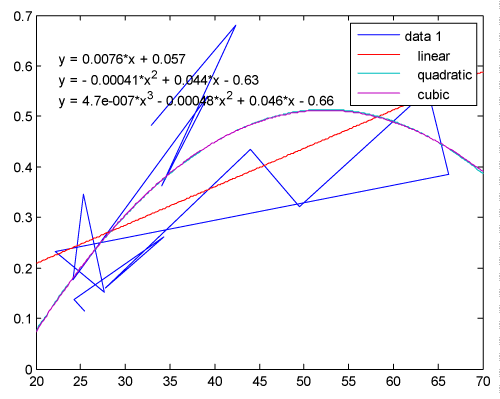| Research Article |
Open Access |
|
| Pratiksha Saxena*, Vinay Pathak and Vinod Kumar |
| School of Applied Sciences, Gautam Buddha University, India |
| *Corresponding authors: |
Pratiksha Saxena
School of Applied Sciences
Gautam Buddha University, India
E-mail: mathematics.pratiksha@gmail.com |
|
| |
| Received May 18, 2012; Published September 27, 2012 |
| |
| Citation: Saxena P, Pathak V, Kumar V (2012) Animal Feed Formulation Using Non-Linear Programming and MATLAB. 1:345. doi:10.4172/scientificreports.345 |
| |
| Copyright: © 2012 Saxena P, et al. This is an open-access article distributed under the terms of the Creative Commons Attribution License, which permits unrestricted use, distribution, and reproduction in any medium, provided the original author and source are credited. |
| |
| Abstract |
| |
| Since 1950, diet formulation models have been developed for commercial and research purposes using different forms of mathematical programming. Purpose of this paper is to develop a technique for animal diet formulation with the objective of maximum animal weight gain. In the first step, this technique involves formulation of objective function using non-linear programming. MATLAB is used as a tool for this purpose. In the second step, solution of formulation is given and is compared to existing techniques. Use of nonlinear programming overcomes the drawback of linear approximation of objective function. The obtained results confirm the benefits of the applied technique. |
| |
| Keywords |
| |
| Nonlinear programming; MATLAB; Animal diet formulation; PACS: 80 |
| |
| Introduction |
| |
| Objective of animal diet formulation is to produce an effective diet at minimum cost to provide appropriate energy to animal. In 1950s, diet formulation was done by electromechanical machine and took one hour to calculate it. In 1980, a computerized linear program is developed and implemented for maximization of income above feed cost. In 90s, a number of software and mathematical programs are implemented to formulate and optimize animal diet. Use of technology is consummating animal diet formulation and leading to a new direction of software automation. |
| |
| As animal feed is indirect human foods, it is necessary to improve animal diet formulation. To achieve highly efficient animal diet, a number of formulation methods have been derived for last many decades. In 1951, first time mathematical programming was used to solve the feed mix problem [1]. Least cost ration is formulated by linear programming for sheep [2]. Chance-constrained programming is used to formulate commercial feeds for animals [3]. Two nonlinear optimization problems are formulated as an iterative sequence of linear programming problems [4]. |
| |
| From early 50-80’s, linear programming was widely used for the purpose of animal diet formulation. Consequently, it is done by Quadratic programming, goal programming, multi-goal programming, multi-objective programming, chance-constrained programming and genetic algorithm. Open and closed formula laboratory animal diets and their importance in research were described [5]. A feed-formula optimizing system is successfully studied based on Windows 2000 Advanced Server, with SQL Server 2000 database and ASP Web-page language and Linear programming together [6]. Feed product had been formulated both with linear and stochastic programming on different probability levels with nutrient averages [7]. |
| |
| Objective of animal diet formulation is to provide necessary energy at different stages of production as growth, reproduction, metabolism and lactation. While formulating objective function, generally impact of nutrient ingredients is approximated by linear relationships. While using linear programming as a tool for animal diet optimization, few limitations were identified. These limitations include probability of nutrient imbalance [8] fluctuating nutrient level in feed ingredients [9], constraint rigidity [10] and linear approximation [11]. While formulating a mathematical model related to real life problems, many different situations lead to nonlinear formulation of constraints and objective function. The importance of Nonlinear Programming applications is growing due to rapidly increasing sophistication of managers and operation researchers in implementing decision oriented mathematical models, as well as to the growing availability of computer routines capable of solving large-scale nonlinear problems. |
| |
| Introduction of nonlinear programming, to optimize yield and minimize feed cost in animal feed formulation, may lead to better approximation as compared to those of linear cases. Complexity of different nutrient ingredients would possibly be better described by nonlinear relationship between them. Present study is carried out to maximize animal weight gain by inclusion of nonlinear relationship between nutrient ingredients and its impact on animal weight gain. Use of nonlinear programming overcomes the drawback of linear approximation of objective function. In this paper, it is envisaged to develop a mathematical model using non-linear programming to take simultaneous effects of all nutrient ingredients. MATLAB is used as a tool for formulation of programming problem. Result of the model is compared to linear programming formulation. |
| |
| Materials and Methods |
| |
| Objective of this study is maximization of animal weight gain for livestock growth. Steps of this technique can be summarized as: |
| |
| • Establishment of relation between weight gain and three nutrient ingredients using MATLAB. |
| |
| • To check the ratio dependency of animal weight gain on different nutrient ingredients. |
| |
| • Establishment of relationship between y and x1, y and x2 and y and x3 (animal weight gain and nutrient ingredients. |
| |
| • F-test to check best fit relation |
| |
| • Objective function as nonlinear relation and constraints as per NRC recommendations. |
| |
| • Optimization of nonlinear diet model. |
| |
| Experimental Design |
| |
| For the experimental design, Muzaffarnagri ewes in advanced pregnancy, were separated and fed as per N. R. C. schedule. The development of the rumen well, after 3 weeks, depends on the consumption [12]. The lambs were weighed as soon as dry and ewes no sooner she dropped the placenta and lambs were group fed. No selection was practiced in assigning lambs to milk intake studies. However, twins, orphans or lambs died during the course of study were excluded. Effect of various levels of metabolic energy to protein, on the growth, nutrient utilization, rumen digestion and metabolism along with carcass composition and wool growth is studied. Details of the four proposed treatments are listed in the table 1. |
| |
|
|
Table 1: Four Proposed Treatments. |
|
| |
| Proposed treatment at 20 kg body weight is given in Table 2 and at 30 kg body weight is given in table 3. During post weaning studies, all lambs were tied individually offered weighed quantities of creep/ concentrate and hay along with free choice mineral mixture and common salt. Drinking water was offered thrice a day [13]. |
| |
|
|
Table 2: Proposed treatment at 20 Kg. body weight (Dry matter intake 700gm.). |
|
| |
|
|
Table 3: Proposed treatment at 20 Kg. body weight (Dry matter intake 900gm.). |
|
| |
| Present study is carried out to optimize the animal diet by maximum utilization of nutrient ingredients. The rate of growth and the efficiency with which the nutrients are utilized mainly depend on three factors, which may be used to maximize it. |
| |
| |
| Accounting all these facts, weight gain of an animal depends upon: |
| |
| 1. Digestible crude protein [x1], |
| |
| 2. Total digestible nutrient [x2] and; |
| |
| 3. Digestible dry matter [x3]. |
| |
| Metabolic weight is used as a base for whole of the calculations [14]. |
| |
| Using MATLAB relation between weight gain and three nutrient ingredients is established as, |
| |
| x3=200;%157.5<=x3<=210 |
| |
| Note: Change the value in x3 and get the plot in y, x1 and x2. |
| |
 |
| |
| Y= -2966703136*10(-6)*(x1)2 + 3115168644*10(-4)*x1 + 1358380624*10(-5) * x2 + 1086861007*10(-4) * x3 – 7.044843364*10(-3); |
| |
| mesh(X1,X2,Y) |
| |
| } |
| |
| Ratio dependency of animal weight gain on different nutrient ingredients is shown in figure 1 and described by eq. (1). |
| |
|
|
Figure 1: Ratio dependency of animal weight gain on different nutrient ingredients. |
|
| |
 (1) (1) |
| |
| With the set of data available, MATLAB is used to establish relation between variables y and x1, y and x2, y and x3. First, Second and third degree polynomial and its graph is shown in figure 2 for variables y and x1. |
| |
|
|
Figure 2: Polynomial relation between y and x1. |
|
| |
| First, Second and third degree polynomial and its graph are shown in figure 3 for variables y and x2, and in figure 4 for variables y and x3. |
| |
|
|
Figure 3: Polynomial relation between y and x2. |
|
| |
|
|
Figure 4: Polynomial relation between y and x3. |
|
| |
| Using F-test, best fit relation between y and x2,y and x2,y and x3 of different degrees is established. |
| |
 |
| |
| Where p is the degree of polynomial and SSRp is sum of square of residuals of pth degree. N is number of observations and α is 5%. |
| |
| Objective function is formulated by using F-test and constraints are formulated according to NRC recommendations and defined by eq. (2) and (3) respectively [15]. |
| |
 (2) (2) |
| |
| Subject to: |
| |
 (3) (3) |
| |
| Result and Discussions |
| |
| Using Kuhn-Tucker conditions, optimum values of three nutrient ingredients are evaluated by Kuhn-Tucker conditions. The objective function is converted to; |
| |
 |
| |
| Solving set of equations, by using Kuhn- Tucker method, optimum value of nutrient ingredients are obtained as, x1 =291.662, x2 =291.662, x3 = 210, subject to the condition: λ1, λ2, λ3≠0. |
| |
| Conclusion |
| |
| Use of nonlinear programming gives better result as compared to use of linear programming because result of proposed model is based on simultaneous effect of all nutrient ingredients. Equation representing individual relationship of variables presents the linear and nonlinear effects of different nutrient ingredients on body weight gain. Use of MATLAB gives a new dimension to this work and can be investigated in future for variables. This paper demonstrates the feasibility of approaching animal nutrition and diet formulation from a cooperative multi-state effort. It depicts that it is possible to compile data from many sources and that a larger data base can provide more meaningful results. It is an attempt to promote more effective application of nutrition data and principles in the development of animal feeding systems. |
| |
| |
| References |
| |
- Waugh FV (1951) The Minimum-Cost Dairy Feed. Journal of Farm Economics 33: 299-310.
- Zioganas C (1983) Least cost ration for sheep by linear programming 33: 58-68.
- Roush WB, Stock RH, Cravener TL, D'Alfonso TH (1994) Interfaces 24: 53-58.
- Munford AG (1996) The use of iterative linear programming in practical applications of animal diet formulation. Mathematics and Computers in Simulation 42: 255- 261.
- Barnard DE, Lewis SM, Teter BB, Thigpen JE (2009) Open- and closed-formula laboratory animal diets and their importance to research. J Am Assoc Lab Anim Sci 48: 709-713.
- Xiong Ben-hai, Luo Qing-yao, Pang Zhi-hong (2002) A study on Animal Feed Formulation System Based on Internet Remote and Interaction. Chinese Academy of Agricultural Sciences.
- Andrea Csikai (2012) Quality Assurance and Safety of Crops & Foods 3: 82-88.
- Zhang F, Roush WB (2002) Multiple-objective (goal) programming model for feed formulation: an example for reducing nutrient variation. Poult Sci 81: 182-192.
- Munford AG (1996) The use of iterative linear programming in practical applications of animal diet formulation. Mathematics and Computers in Simulation 42: 255-261.
- Munford AG (1989) A microcomputer system for formulating animal diets which may involve liquid raw materials. European Journal of Operational Research 41: 270-276.
- Saxena Pratiksha (2006) Application of nonlinear programming in the field of animal nutrition: A problem to maximize the weight gain in sheep. National Academy Science Letters29:59-64.
- Morrison FB (1957) Feeds and feeding .(22ndedn), The Morrison publishing company, New York.
- Bhatia DR (1977) Effect of Variable Caloric Density Rations on Rumen Metabolism and Efficiency of Meat Production in Muzaffarnagri Lambs.
- Maynard LA, Loosli JK (1962) Animal nutrition. (5thedn), Tata McGraw-Hill.
- Report of Commission on Natural Resources, National Research Council, National Academy Press, Washington, D. C (1981).
|
| |
| |
 (1)
(1)
 (3)
(3)




